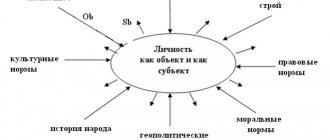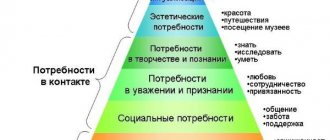The concept of motive and motivation in psychology
Definitions differ in their meaning. Often they complement each other or form a complex system of behavioral reactions and choice of activity. In a simplified version, motive means the reason or motivation for a certain action.
Motivation is the driving force that serves as a product of mental activity, generated by a stable psycho-emotional state, views or worldview. It forces you to make decisions for the long term.
In psychology, motive is a narrower concept that stimulates behavioral activity and is aimed at quickly achieving a goal. Both terms were coined by the German philosopher Arthur Schopenhauer. Understanding the conceptual difference between them is important for assessing the factors that control an individual's behavior.
Psychologists have a dual meaning for motivation. On the one hand, it is a set of motives, on the other hand, it is a process of a set of actions aimed at achieving goals in the long term. Motivation is a multifactorial system that determines social or biological behavior.
Motive in psychology
The desire to achieve a specific result of activity serves as a goal and at the same time a motivating circumstance. A motive is often presented as a special emotional experience that is transformed into a directed action. Motivation is used when choosing a path.
The motive operates when making local decisions within the framework of a general direction or vector. It can be presented in the form of a speculative generalized image of material or idealistic values that act as the subject of aspiration, claim, and lust.
Types of motives
The psychological category is difficult to classify. There are an innumerable number of circumstances that motivate action. Often they do not fit into the framework of harmonious concepts. Each school of psychology develops its own system for classifying motives.
In the generally accepted view they are:
- hidden;
- obvious;
- social;
- household;
- physiological;
- biological.
Depending on the nature or focus, motives are classified according to content, origin, and duration. There are varieties distributed according to the strength of manifestation, level of awareness, and area of activity.
Based on content, the following types of motives are distinguished:
- Ideological. They affect the ideological part of the personality. People are guided by such motives even at the risk of harming themselves.
- Political. They largely overlap with the previous variety. Such motives reflect the political position of the individual. They are often based on the desire for leadership, recognition, and popularity.
- Moral and ethical. They define social behavior and indicate clear boundaries of what is acceptable. This type of motive is based on generally accepted principles of morality, which are not the same in different social formations.
- Aesthetic. The most harmless, constructive category of motives. They guide the choice of profession as an artist, musician or designer.
Classification by origin (source) divides motivating factors into social, collective, and incentive. This includes work motives that are formed under the influence of professional affiliation or type of activity.
Social behavioral criteria take into account the interests and rules of the social formation to which a person belongs. Many everyday actions are subordinated to this type of motive.
Collective motivating factors involve taking into account the interests of the group to which the individual belongs. Incentive motives force you to leave your own comfort zone for the sake of achievements or striving for new heights in life.
The basis of such behavior is always a thirst for material wealth. This is the most important type of motive that forces us to learn, make discoveries and inventions. Below are 4 main generalized groups of incentives.
Internal and external
Such motivating factors are of enormous importance for choosing a goal and determining the means to achieve it. They are aimed at revealing one’s own potential and demonstrating individuality.
In psychology, a motive is an internal urge or external circumstance that encourages a certain action. The first is associated with the emotional state, ideological position, and range of interests of the individual.
Internal motives are aimed at:
- increased self-esteem;
- realization of natural abilities;
- satisfying the need for positive emotions;
- achieving life comfort;
- acquisition of material goods;
- doing one's own duty;
- showing love and care for loved ones.
Such incentives to action are considered stable, unchangeable over time. For example, a student’s desire to learn a lesson is determined by internal motives - interest in the subject, thirst for new knowledge, and the desire to get a high score.
This brings moral satisfaction from a job well done. External motives are associated with circumstances that indirectly or indirectly depend on the will of a person, the sphere of application of his efforts.
A typical example is choosing wardrobe items according to the season or the desire to take an umbrella with you in anticipation of rain. Public opinion, comfort, and the vagaries of nature do not depend on internal factors of the individual. They create motives called external ones.
Good performance of assigned work, professional duties, and the desire for personal growth pursue the goal of increasing one’s own value in the labor market. Here there is a clear combination of internal motives from those cited earlier in the article with external ones, determined by the current situation.
The latter play a crucial developmental role, forcing them to compete. What matters is social encouragement or condemnation, which is inextricably linked with the choice of external motive. They are more effective than internal ones, therefore they are used to control the behavior of an individual.
Positive and negative motives
Such factors are subject to and subject to emotional influence. They are aimed at satisfying the natural need for positive moral feelings. The desire to avoid negative emotions determines the choice of path or sequence of actions.
Negative feelings include:
- fear;
- anxiety;
- moral torment;
- physical pain;
- the desire to avoid punishment for an offense.
An individual always subconsciously tries to choose the course of action that will provide positive emotions and exclude negative ones. Such motives are called positive or negative.
Psychologists disagree about the effectiveness of such motivating factors. Fear and the instinct of self-preservation are considered incredibly powerful stimuli. Negative motives are aimed at overcoming obstacles standing in the way of a goal.
Stable and unstable
The first are based on natural needs and requirements. Therefore, stable motives do not need additional reinforcement. They remain relevant in the long term.
Unsustainable motives are subordinated to situational goals and the satisfaction of immediate needs. Factors inducing action based on worldview, personal interest, and taste preferences are particularly stable.
Achieving success
Based on promoted life values. Social norms encourage individuals to strive to achieve success in life. A special system of standards has been created with an understanding of prestige and respectability.
They are equivalent to the concept of success and are aimed at creating the required motivating factors. The system of modern value guidelines has elevated a certain scale of achievements with attributes of high social status to the top of the psychological hierarchy.
There are many obstacles on the path to success in life. To overcome them, powerful motivation is required, which consists of material wealth, personal comfort, and public recognition. To get closer to a distant and elusive goal, intermediate milestones are outlined. Achieving each of them is a separate motivating factor.
In psychology, motive is also a progressive, systematic, consistent movement towards a global life goal. This path often requires leaving your own comfort zone. It is the motive that makes a person decide to take such actions.
Under the influence of an incentive, an individual sacrifices little to solve a global problem. In psychology, a comfort zone is understood as a personal mental, physical and spiritual space that a person is willing to sacrifice in order to achieve a goal with expected compensation.
All people verbally declare their desire to achieve success, but not everyone is ready to make sacrifices for it. The corresponding motive is intended to compensate for the costs on the thorny path to high social status. Here a hidden motivating factor of a subconscious nature often comes into play.
Self-motivation
A person’s actions are stimulated by his desire or desire to improve his life position. In other words, a person can independently convince himself that it is necessary to act, even if something is not going well.
This process is individual, and a person can decide for himself how to motivate himself or use internal motivation. But there are also methods that have a positive effect on most people. Manipulators often and skillfully use such methods.
Functions of motives
To explain the background of any behavior, reactions to changes in conditions or actions in psychology, extrinsic (external) or intrinsic (internal) reasons are used. They are closely related to the basic functions of motives. There are 3 of them - motivation, direction, regulation.
Psycho-emotional qualities are considered external factors that determine an individual’s behavior:
- satisfaction of natural needs;
- achieving your goals;
- realizing your own desires;
- following your interests or hobbies.
The incentives that guide behavior are based on the functions of motives. Motivation provokes the commission of certain actions, gives psycho-emotional impulses or emotional impulses relevance.
The guiding function helps to choose the right path to solve a problem. Regulatory forces one to adhere to the mores, norms and rules prevailing in a social environment or social group. It gives legitimacy to internal motives.
Functions are similarly influenced by external stimuli. When guided by extrinsic motives, they activate other characteristics of the individual. Therefore, motivational functions in psychology are considered in a dual context.
Some are classified as biological, considered innate, and provide survival. Such functions of stimulating factors are aimed at satisfying basic physiological needs - satisfying hunger, thirst, sleep.
They are inherent in any biological organism, since they are dictated by nature. Maternal instinct is considered one of the most powerful motivating factors. The biological functions of motives include thermoregulatory, excretory, and the desire to avoid pain or discomfort.
People are characterized by secondary stimulating factors acquired during life, dictated by the prevailing external conditions and social environment. Interpretations of the functions of the motifs are given in the table.
| Function | Characteristic |
| Balance | It is activated when an individual experiences a deficiency in something and acts until the lost balance is restored. |
| Needs | Serves as a response to the desire to satisfy physiological, psycho-emotional, aesthetic or other needs. |
| Cognitive | Encourages actions aimed at achieving a set goal or solving a current problem. |
| Behavioral | Dictated by social rules and norms, may change depending on external conditions. |
The motif has selective functions and individual properties that change over time. In psychology this is called adaptive ability. Inducing factors and their functions are not the same in terms of their impact on the individual.
"Theory of Needs" by A. Maslow
Today there are quite a few theories of motivation, but the work of A. Maslow, “The Theory of Needs,” is most often taken as a basis. The defining idea of the theory's creator was that every person has a hierarchy of needs. And some needs are satisfied only after basic needs are satisfied. Maslow gave as a basis the physiological needs of the individual, that is, those associated with survival (food, water, rest).
The second level of need is security and confidence in the future. A person strives to protect himself in the outside world and establish himself in the future.
Social need reaches the next level. This is a person’s attitude towards society, the desire for communication and the need for support.
The need for respect takes the next step. There is a desire to impress people and earn respect from significant others.
The final stage is occupied by the need for self-expression. This is when a person tries to realize his personal potential.
Levels and types of motivation
Without connection with the stimulus that ensures the development of the individual, the levels of motivation are transformed and the strength of influence changes. There are 2 main types of motivating factors: dictated by internal reasons or external circumstances.
The former do not allow you to give up when you fail, the latter are aimed at achieving public recognition. According to Freud, there are male and female types of motivation.
In a simplified version, the first is focused on saving existing reserves, the second is on finding additional resources and sources. Each psychological school offers its own interpretations of the types of motivation.
The following classification of levels of stimulating factors is popular:
- Perspective visualization. It involves creating a clear guideline, an image of the desired future.
- Stability of perspective. The individual seeks confidence that living conditions will remain unchanged in the foreseeable future. Both internal and external motivation are based on this.
- Activating perspective. When approaching a goal, an individual subconsciously intensifies the desire to reach it, and accordingly the level of motivation increases.
- Stagedness. Complex goals require step-by-step planning. The proximity of each subsequent intermediate point does not allow motivation to weaken.
S. Polukeev, based on an analysis of the works of L. Gumilev, proposed 9 levels of motivation. Each reflects the strength of the individual’s incentives, his psychological state, and the strength of his life’s aspirations.
Depending on the goals being achieved, tasks being solved or actions being performed, the level of motivation decreases or increases. The determining factors are considered to be the significance of the result, confidence in achieving the goal, and personal forecasts regarding the possibility of achieving what was planned.
Signs of a motivated personality
People who are charged with action can be easily recognized. They:
- optimistic (a motivated person is confident in advance of a good result);
- active (show enthusiasm, which helps not to stop in the process of achieving the goal);
- persistent (follow the rule that any obstacles that arise can be overcome);
- concentrated (try not to be distracted by small things);
- self-confident (they feel like a whole person with their shortcomings, but at the same time they not only know how to use their strengths of character, but also work on their weaknesses).
Basic human motives, examples
The main factors stimulating and determining the behavior of an individual include those aimed at biological survival. They are laid down by nature and cannot be changed by willpower.
Some of these motives are cyclical in nature - food intake, sleep and wakefulness phases. Obvious examples are obtaining food and extracting additional resources. The main motives stimulate the work activity of an individual and economic processes in social formations.
The accumulation of material assets, the production of basic household items and food products are aimed at satisfying natural human needs. This includes the production of heating products. The motivation for such activity is to increase life expectancy.
In psychology, a motive is an individual’s desire to satisfy his own basic needs. Such considerations force states to develop science, technology, and medicine. At the heart of complex economic and social processes lies a simple desire to satisfy the basic needs of all members of the social formation.
Many basic motives are not given importance in everyday life, but they act as the driving force of any activity. Such stimulating factors include the subconscious desire to avoid danger, dictated by the instinct of self-preservation.
The search for shelter, the desire to protect oneself, to create the most favorable conditions for life are considered the main and fundamental motives. The main behavioral stimuli are individual psychological characteristics that have a strong influence on a person’s actions in different situations.
They are socially conditioned or have a personal innate nature. Motivation can be functional and serve the purposes of cultural development of the individual. Such incentives force people to buy expensive tickets to a concert, theater, or contemporary art exhibition.
Application in various fields
Psychologists have identified different methods of motivation that can be effectively used in work, relationships, etc. The most effective include methods used in psychology, management, and economics.
In psychology
Techniques:
- Self-hypnosis is a process by which a person independently influences his psyche. The main goal is to change behavior, actions, beliefs, interests. With the help of self-hypnosis, a person can make his behavior unusual. For the method to work, you need to prepare a list of attitudes and statements that seem correct. When making statements, you cannot use the particle “not”.
- Affirmations are expressions or small texts that can be used to influence a person on a psychological level. For affirmations to work, you need to divide a blank sheet of paper into two parts. On the left write negative statements that cause fear and anxiety, on the right - positive ones. It is important to write down negative statements in detail to reveal hidden fears. After this, you need to cut the sheet into two parts, carry the side with positive affirmations with you constantly, reading them every day.
- Self-motivation is the desire, the desire to continue activities when natural motivation is lost. You need to constantly look for reasons that will make you continue to act so as not to give up.
In management
Motivation techniques used in management:
- Economic - material incentives. These include increased wages, financial assistance, bonuses, and loans.
- Non-economic - moral, psychological or organizational. These include praise, support, approval, trust, respect, blame, prospects for further growth, delegation of authority, tasks.
In economics
The main methods of motivation in economics:
- penalties;
- social payments;
- rewards.
What is the subordination of motives?
This is a key concept in the formation and development of personality. The first signs of subordination of motives appear at an early age. Various stimulating factors lose equal importance and form a system of personal values and life guidelines.
This structure is called an individual motivational scheme. Dominant and secondary motivations constitute a hierarchy in which there is a difference in levels and strength of influence.
Subordinate motives of adolescence include:
- self-affirmation;
- desire to achieve sports success;
- the emergence of moral qualities;
- behavioral assessment.
To prevent ethical deformation of the individual, subordinate motives are built into a hierarchical system by educational means. The most difficult moment during the period of an individual’s psychological formation is the choice between personal and social values.
The subordination of motives is formed in the struggle of these factors to create a reasonable compromise. It starts in preschool age. The result of this step-by-step process is considered to be motivational readiness, which is closely related to the concepts of cognitive interest and initiative.
The problem of the struggle of motives
At the same time and in parallel, the individual is under the influence of numerous multidirectional stimulating factors. This is the most important concept of volitional activity. The struggle of motives is aimed at determining the dominant and dominant stimulus.
Its logical outcome is the formation of a mature personality, understanding of life priorities, and the ability to make decisions independently. Some motives have ambivalent meaning. Example: is it worth accepting the help of an unpleasant or a priori unfriendly person?
Such dilemmas that haunt an individual throughout his life constitute the essence of the struggle of motives. A typical example is a choice between positive but incompatible goals. Making a decision often requires willpower. It is not recommended to make difficult life choices under the influence of emotions.
Motive in psychology is also a constant struggle of multidirectional stimuli and motivations. A clear definition of value guidelines helps you make error-free choices. Psychologists recommend drawing up a personal motivational scheme to ease internal struggles.
How to correctly determine motive and motivation?
Personal psychophysiological stimuli regulate the behavior of an individual and serve as the basis of a person’s mental sphere. Motivation is the driving force that organizes motivating factors and combines them into a coherent system.
A well-built hierarchy makes it easier to achieve goals and increases efficiency. To correctly determine your own motives, dividing them into dominant and secondary ones, deep introspection is required. In psychology, this is considered a fundamental factor in the formation of a harmonious personality.











